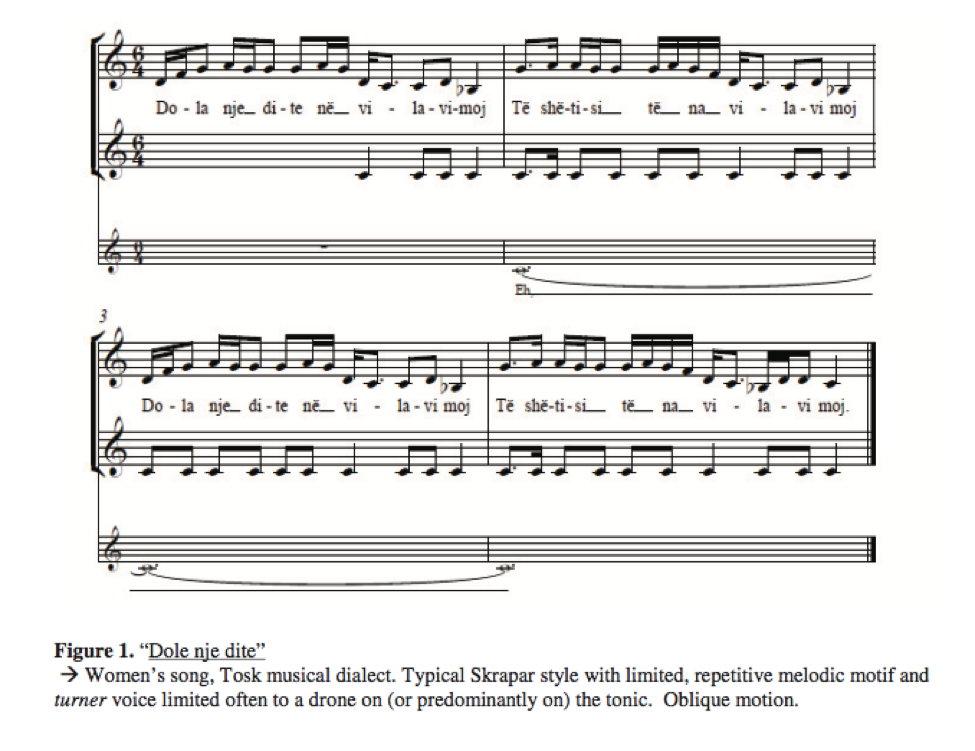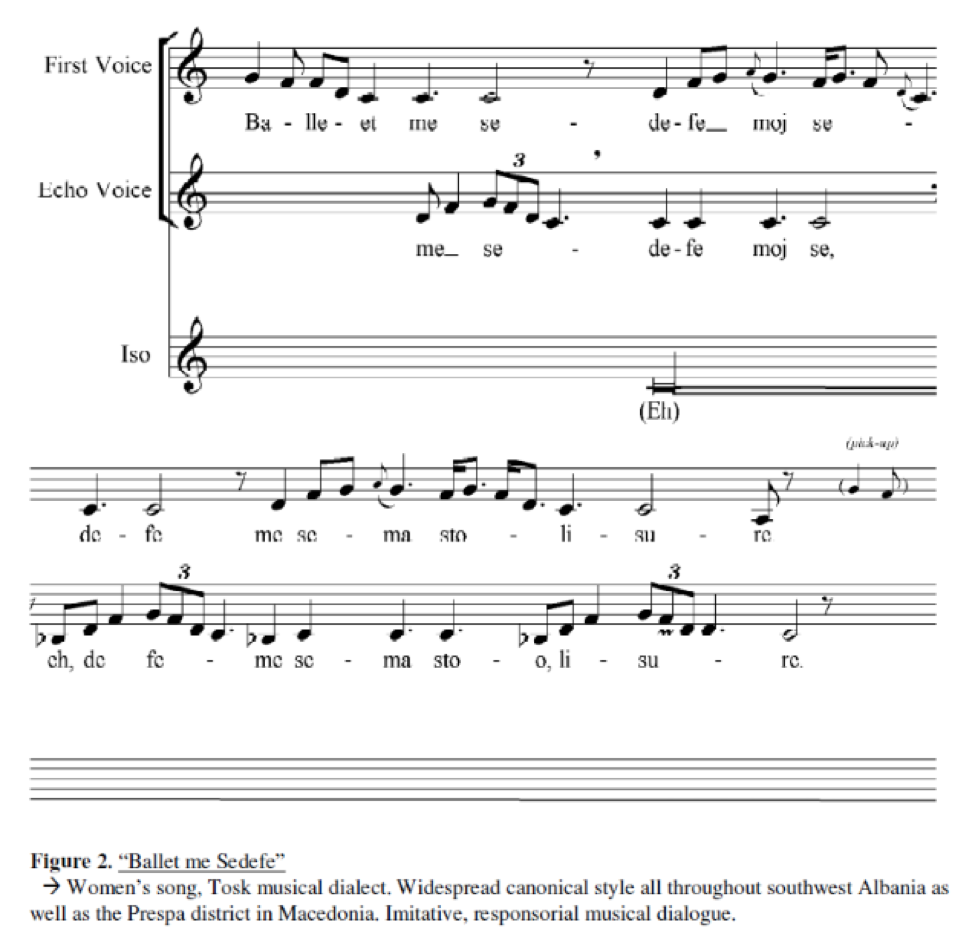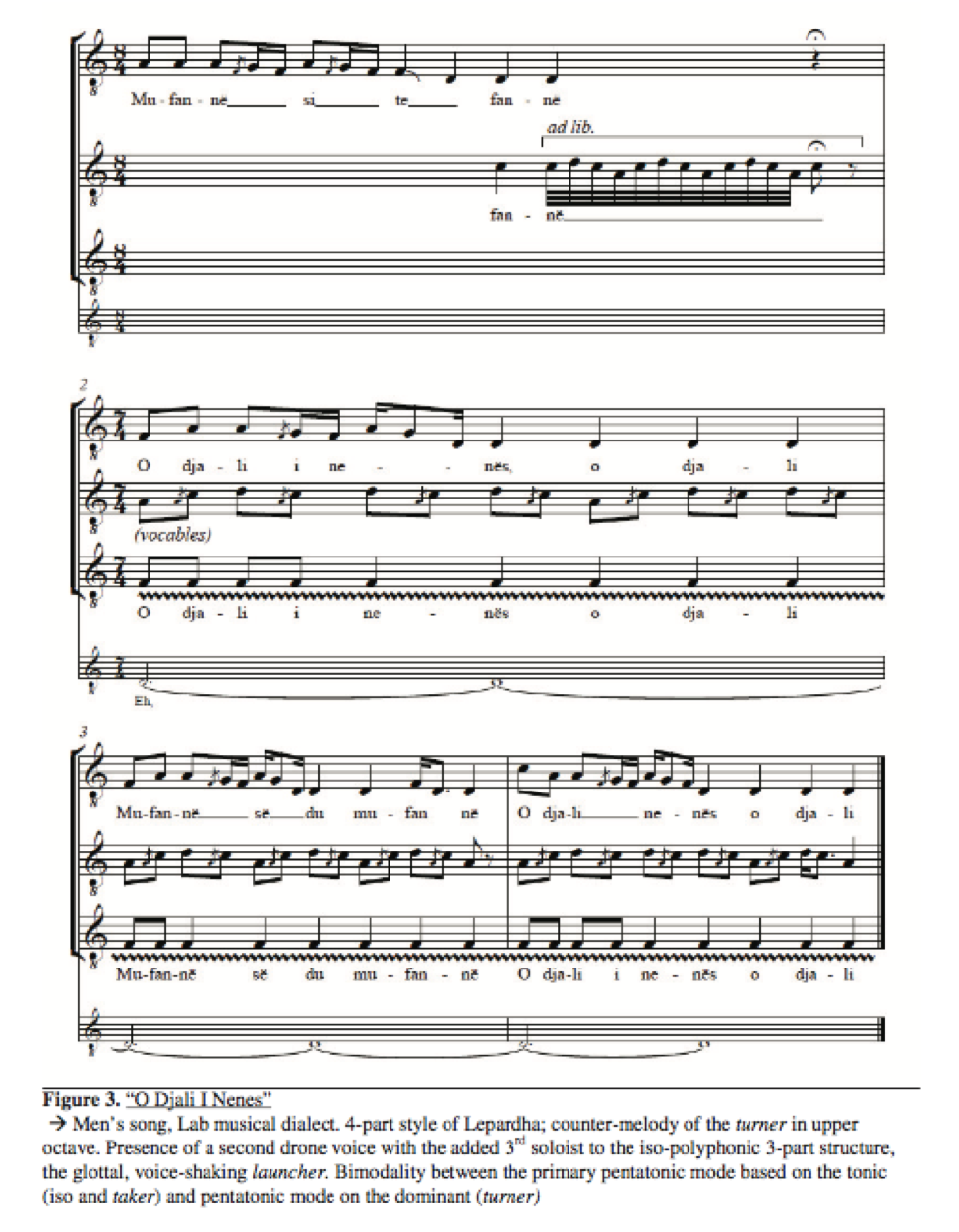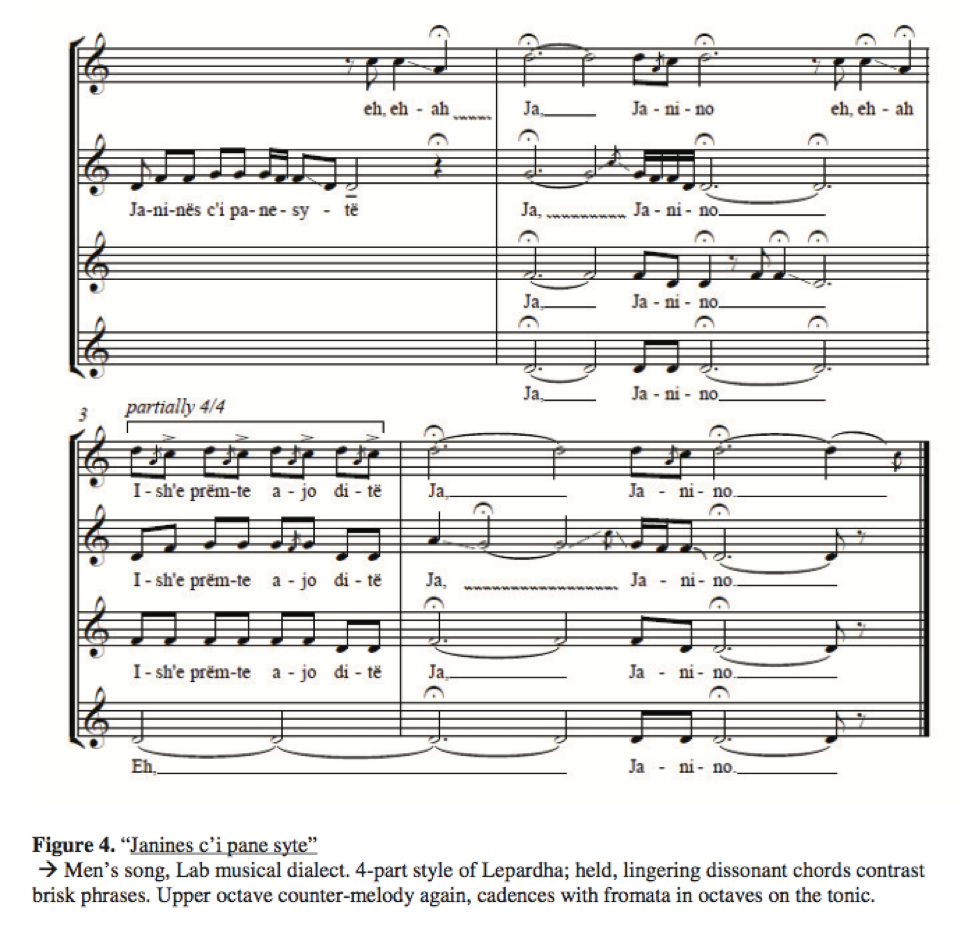
The original study that this paper is based on investigated shared musical elements of a form of traditional multipart singing, also known as “iso-polyphony” (Ahmedaja 2008; Jordania 2006) found in southern Albania, northwestern Greece, and southwestern Macedonia. Borrowing models from established scholars who have been engaged with polyphonic vocal practices on an ongoing basis, the investigation focused on the musical transcription and analysis of select regional styles that are unique dialects of a common musical language. This paper draws from the original and centres on two Albanian musical dialects of iso-polyphony that serve as the framework for a case study concerning the advantages and challenges of using the language and approaches of Western music theory and ethnomusicology for the analysis of traditional music.
Keywords: Albania, Balkans, ethnomusicology, iso-polyphony, musical languages
Albanian and Epirote polyphony, commonly referred to in recent scholarship as iso-polyphony (Ahmedaja, 2008; Shetuni, 2011), is a part of the folk polyphonic singing tradition of the southern region of the Balkans, commonly associated with the historical territory of Epirus. This style of folk singing can be described as primarily a musical dialogue between soloists with the support of a choral drone. Although iso-polyphony is primarily identified with the folk musical culture of Albania, often as a result of its utilization as a propagandist tool in Albanian nationalism during that country’s Socialist era (Shetuni, 2011), it is essentially a transnationally disseminated style of multipart singing with variant manifestations of the same foundational polyphonic structure. These variants are defined by different ethnolinguistic and regional divisions in northern Greece, parts of Albania, Macedonia, and southwestern Bulgaria. Thus, iso-polyphonic singing, in terms of its geographical distribution, is not a tradition that belongs to a specific people or musical culture, but instead to a region of the Balkans cohabited by multiple peoples who have developed their own distinctive expression of it. Scholarship in English dealing with the practice of iso-polyphony focuses primarily on Albania and approaches the topic from the perspective of nationalism, framed in anthropological and cultural studies theory. Albanian scholars, for example, sometimes suggest romantic and difficult-to-prove claims regarding the origins of iso-polyphony, insisting on a unique, inherited musical language that dates back to their Thraco-Illyrian ancestors (Shetuni, 2011) and on how multipart folk singing traditions functioned as a symbol compatible with the nationalist ideals of Communist Albanian identity (Shetuni, 2011). An important fixture in festivals and broadcast media, this symbol was elevated to the status of a nationalist avatar of Albanian culture.
In the analysis that follows, I will utilize a linguistic model of musical styles commonly found in scholarship dealing with iso-polyphony (Jordania 2006, 2010; Shetuni 2011) to explore the notion of “dialects” of shared musical traditions.
A theoretical framework is central to musical analysis, and in this forum I have chosen to employ Western concepts and theory, despite the debate regarding its use in the study of folk music, particularly for some ethnomusicologists and anthropologists who sometimes have a more vested interest in contexts for performance practice and other matters. In “Who Asked the First Question,” an online analytical survey of global folk polyphonic traditions, Joseph Jordania (2006) discusses the suitability of his analytical model. My position echoes that of Jordania in scrutinizing, for example, the use of the term polyphony, a concept in Western art musical practice that refers to musical texture with two or more independent melodies, but is limited in its use for the many diverse styles of folk polyphony that are often partially improvised.
Some ethnomusicologists have made efforts to reform the musicological language to describe such traditions from an “insider” or emic perspective. One excellent example is the function of pedal, choral drones which will be addressed further in the paper. A musicologist, for example, could argue that a pedal drone has no independent melodic role and should not be considered a separate musical line, but rather a means to enrich a main melody. An ethnomusicologist, however, would modify the analytical constructs so that their work might be more comprehensible to a broader circle of scholars.
My understanding of musical texture in this paper is not that of “polyphony” in the Western sense with its “independent” voices, but rather of a “multipart” texture or structure with “interdependent” voices where the different components are given their melodic quality only in the context of the musical lines being synchronous. I do not entirely discount the use of the term polyphony, but concur with Jordania (2006), who suggests the recognition of subgenres of folk polyphony or multipart singing that denotes specific traditional structures more precisely.
Because the folk music being investigated is strictly a vocal tradition, analysis of the central components of vocology will be examined, such as vocal placement and extended vocal techniques (glottal stops and pulsations, yodelling, and outcries), styles of ornamentation and timbre, and melodic modes that enrich the style. An examination of the horizontal and vertical characteristics of melodic lines will contribute to an understanding of differences and similarities in the interdependent relationship between the voices as they align in performance. As both a performer and researcher of the traditions under investigation, I should point out that I am in favour of using the language of Western musical theory for conveying certain musical concepts that will become clearer in the paper.
Iso-polyphony refers to a form of three-part singing with soloists accompanied by a chorus who sustain a continuous tone, commonly known as a “drone” or “pedal drone,” to one syllable throughout. Three-part iso-polyphony is composed, naturally, of three structural components. These include the marrës or “taker,” the kthyës or “turner,” and the iso or “choral drone.” The terms “taker” and “turner” describe the imitative dialogue that occurs between the two soloists who are supported by the iso sung on the tonic or tonal centre. Iso as a structural element is similar to the ison of the Byzantine chant. Although the similarities between the two are recognizable, further research is required to substantiate clear connections (Koço, 2012). Vocal timbre is often nasal, frontally projected, and embellished with various levels of vibration.
The modes or scales used for Albanian and Epirote iso-polyphony are pentatonic (five tones) and vary according to the ethnographic regions in which they are found. The aforementioned three-part structure acts as a foundation not only for Albanian and Epirote iso-polyphony, but also as a defining attribute of multipart singing styles in the Balkans that are part of one greater tradition. Variants of this greater tradition form musical dialects with their own particular features.
Albanian scholars (Ahmedaja, 2008; Jordania, 2006, Koço, 2004, Shetuni, 2011) distinguish between two main forms of iso-polyphony as practiced by two of the most notable subcultures of southern Albania, the Labs and Tosks, who are located in the regions of Labëria and Toskëria, respectively. Although the Tosk style is more widespread, more attention has been paid to the four-part styles among the Labs. I will begin with the Tosk style of iso-polyphony as it serves as a foundation for other styles of multipart singing as practiced by ethnic minorities that sometimes reach beyond Albania’s borders.
In Tosk three-part iso-polyphony, a musical dialogue between two voices is supported by a sustained, choral pedal drone on the tonic, sung to one syllable. Variant styles are not common and performance practice is highly gendered in the sense that mixed-gender group singing does not occur (Sugarman, 1997) with the Muslim population. Ethnomusicologist Jane Sugarman (1997) observed a phenomenon she refers to as “engendering” while conducting research with Muslim Albanians and their traditional folk music in the Macedonian region close to Lake Prespa. There she noticed that when performing polyphonic songs, Muslim women sang with more vigour than men when they aged in comparison to their youth when they were more subdued.
In Tosk iso-polyphony, the “turners” and “takers” engage in a dialogue that is stylistically diverse, imitation being the most dominant strategy. Lab and Greek styles are more vertically oriented in contrast to the horizontal dimensional alignment of voices in Tosk polyphony. In the simplest style of musical dialogue, the “turner” sings the text rhythmically to the tonic drone, which is also sounded by the chorus as a pedal drone (Appendix, Figure 1). The “taker” executes a melody that consists of a short melodic motif that is repeated several times, with the drone sung underneath the motifs. The “turner” performs the drone with greater freedom than the choral drone resulting in the development of independence in the roles of both the “taker” and the “turner.”
The widespread canonical style of diaphonic musical dialogue between the two main voices more clearly exemplifies the aesthetic of responsorial imitation that is central to the tradition. Canonical dialogue can be described as the weaving of a simple melodic motif between the first and second soloists while the remaining one sings the drone on the tonic (Appendix, Figure 2).
A third widespread style of imitative dialogue is the use of call-and-response exchanges between the two soloists over the drone, in which the voices are not synchronous but are continuations of each other’s melodic phrases, which are highly ornamental and expressive. This imitative model is the basis for distinctive variants formed from it.
Lab polyphony, despite being limited to a fairly small area, is a living and well- known tradition. This is true even among Albanians outside of the traditionally southern domain of iso-polyphony who were part of a cultural arena in which Lab song, with its ideals of cultural capital and Albanian identity, was widely circulated through the propagandist media promoted by Enver Hoxha. Hoxha, a Lab, grew up in a culture with songs in praise of significant Albanian historical figures and commissioned songs to be “composed” in traditional style in his honour. He was particularly fond of the urban folk style of Gjirokaster, his place of birth, which is an important cultural hub of Lab polyphonic song. The development of the Gjirokastrian expression of Lab song during this time can be attributed to his personal connection to it.
The Lab style of polyphony is notably different from the Tosk style. The musical dialogue takes on a different form, which is mostly contrapuntal. This results in a musical texture where the two voices move in contrasting fashion in such a way that they are not necessarily independent of each other. This dialogue is performed in two different melodic modes with the iso as the binding element between them. Lab polyphony is very strophic, rhythmic, and recitative-like, with less elaborate ornamentation executed by the “taker.” Most commonly, the song form is ABAB with the A section often in free rhythm, the iso performed as a pedal drone, and the “launcher,” or fourth voice, sliding frequently between the third degree of the scale and the tonic. Simple or additive meter is found in the B section which is in direct contrast to the melodic and rhythmic quality of the previous section. This contrast between slower, held-out phrases and brisker, rhythmic phrases is widespread throughout most documented styles of Lab polyphony.
The regional Lab style found in the villages of Lepardha (southwest, inner Albania) was quite isolated and unknown in the past, but is now one of the most recorded and performed styles of Lab polyphonic song. Although typically the “turner” voice is placed on the dominant degree below the iso, in the Lepardha style it is performed with an expressive head voice on the same degree of the scale in the upper octave, rendering the counter-melody of the “taker” as the highest voice, and the iso as the lowest voice in the texture. This uniquely Lab form of alignment and vocal exchange is quite distinct and not particularly widespread outside of this sub-region. Appendix, Figure 3 displays the unique Lab component of a “launcher” voice on the third degree, as well as the “turner” with a counter- melody in the upper octave.
Appendix, Figure 4 is one of the most frequently performed examples of the Lepardha regional style, a historical song that tells of three Albanian rebels who strike down a pasha (a high-ranking Ottoman official) in the city of Ioaninna (capital of present-day Epirus, Greece). In this example one can observe an aesthetic that differs considerably from those associated with other Lab regions and is characterized by a more subdued vocal quality and dense, dissonant, and sustained chords.
Lab polyphonic song is at its most developed form in the urban folk styles of Gjirokaster and Vlorë. Four-part Gjirokastrian polyphonic style is essentially five- part, for there are two main “taker” voices, always performed by a woman and a man who take turns going between the drone and main melody in sequence, much like the canonical dialogue present in the Tosk style. The vertical dimension is highly active because of the presence of three, rather than two solo voices. The iso in Gjirokastrian song is typically performed by a very large group to support the main soloists.
What has become clear in the course of formulating the key contrasting characteristics between Lab and Tosk polyphonies is that the role of each individual part plays a decisive role in the analysis. The main differences stem from the horizontal and vertical alignments within which the polyphonic structures operate. Tosk polyphony, for example, is characterized by sequential phrases, and diaphonic musical dialogue overtop a pedal drone that is horizontally aligned. This constitutes an aesthetic that favours the melodic quality of one or two elaborate and expressive standalone melodies. Lab iso-polyphony, on the other hand, is vertically aligned, exhibiting an aesthetic that favours the melodic quality of simpler or less-elaborate melodies only in conjunction with other melodies. In fact, Ahmedaja (2008) noted the interdependent relationship of Lab singers when attempting to record songs in the field without sufficient people for all the parts. The singers then refused to sing because they were unable to successfully recreate the traditional mode of performance (Ahmedaja, 2008).
It has been the aim of this paper to illustrate that there is value in analyzing multipart folk music with terminology and models developed by theorists in the Western art music canon. Although the concepts were developed for a different aesthetic and purpose, the use of such language, with its related theoretical constructs, can extend beyond the scope of Western art music and be applied to folk polyphony in order to facilitate a sound theoretical analysis of traditional music. I support the notion of not only a theoretical, but also a culturally sensitive analysis of folk polyphonic styles that can begin at the regional level and then serve as the foundation for further studies that contribute to a broader understanding of such unique sonic phenomena.
Ahmedaja, A. (2008). Changes within tradition: Parts and their number in multipart songs among Albanians. In A. Ahmedaja & G. Haid (Eds.), European voice I: Multipart singing in the Balkans and the Mediterranean (pp. 209-266). Vienna: Böhlau.
Jordania, J. (2000). Georgia. In T. Rice, J. Porter, & C. Goertzen (Eds.), The Garland encyclopedia of world music (vol. 8; pp. 826-849). New York: Garland Publishing.
Jordania, J. (2006). Who asked the first question? The origins of human choral singing, intelligence, language and speech. Tbilisi: Logos.
Jordania, J. (2010). Georgian Traditional Polyphony in Comparative Studies: History and Perspectives. In R. Tsurtsumia & J. Jordania (Eds.), Echoes from Georgia: seventeen arguments on Georgian polyphony (pp. 229-248). New York: Nova Science Publishers.
Koço, E. (2013). The Iso(n)—a participatory component in the south Albanian multipart unaccompanied singing and in Byzantine chant. (ff. 333-338). Tbilisi.
Rice, T. (1977). Polyphony in Bulgarian folk music. Washington: University of Washington.
Shetuni, S. J. (2011). Albanian traditional music: An introduction, with sheet music and lyrics for 48 songs. Jefferson, NC: McFarland.
Sugarman, J. C. (1997). Engendering song: Singing and subjectivity at Prespa Albanian weddings. Chicago: University of Chicago Press.
Albania: Vocal and Instrumental Polyphony [CD]. (1994). Paris: Le Chant du Monde.
Cellier, M. (2002). Mysterious Albania [CD]. West Sussex, UK: Arc Music Productions.
Ensemble Tirana. (2007). Chants polyphoniques d'Albanie [CD]. Burbank: Iris Music.
Reinhard, U., & Reuer, B. B. (1999). Music from Albania [CD]. Nashville: Rounder Select.
Sugarman, J. C. (1997). Engendering song: Singing and subjectivity at Prespa Albanian weddings [CD]. Chicago: University of Chicago Press.
Vuylsteck, H. C. (1988). Yougoslavie 2 (Macédoine : polyphonies tosques) : Sous les peupliers Bilsht [LP]. Arles: Harmonia Mundi France.APPENDIX
Figure 1. “Dole nje dite.” Women’s song, Tosk musical dialect. Typical Skrapar style with limited, repetitive melodic motif and turner voice limited often to a drone on (or predominantly on) the tonic. Oblique motion.↵

Figure 2. “Ballet me Sedefe.” Women’s song. Tosk musical dialect. Widespread canonical style all throughout southwest Albania as well as the Prespa district in Macedonia. Imitative, responsorial musical dialogue.↵

Figure 3. “O Djali I Nenca.” Men’s song. Lab musical dialect. 4-part style of Lepardha; counter-melody to the turner in upper octave. Presence of a second drone voice with the added 3rd soloist to the iso-polyphonic 3-part structure, the glottal, voice-shaking launcher. Bimodality between the primary pentatonic mode based on the tonic iso and taker) and pentatonic mode on the dominant (turner).↵

Figure 4. “Janines c’I pane syte.” Men’s song. Lab musical dialect. 4-part style of Lepardha; held, lingering dissonant chords contrast brisk phrases. Upper octave counter-melody again, cadences with fromata in octaves on the tonic.↵
